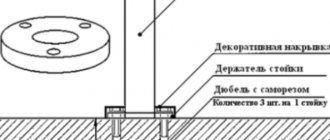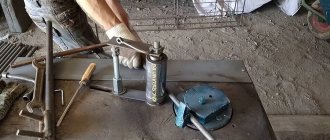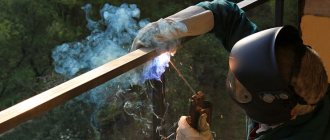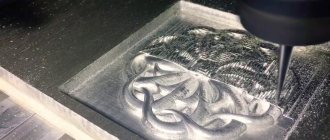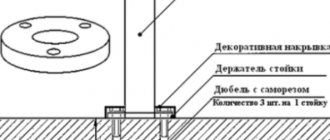At least once, you have wondered how to cut a pipe evenly at 45 or 90 degrees. Either along or across. We give answers to these questions.
Quite often, when performing various construction or repair work, it becomes necessary to cut a pipe. This could be plumbing work, laying pipelines or installing heating systems, but in any case it is necessary to know how to cut a pipe evenly. Some features of performing this task will be discussed further.
One particular example of such a situation is the need to cut a metal pipe at an angle of 45 degrees. Such cutting of material is often required when laying water pipes or heating systems. In this case, you have to deal with steel pipes. For these purposes, conventional cylindrical pipes are usually used. If we are talking about the installation of some kind of metal structures, then profile pipes of rectangular or square cross-section are more often used. The main problem here is that in order for the elements to be connected to coincide, the cut must be as smooth as possible, which means that especially close attention should be paid to marking the material.
In cases where cutting at an angle is required, a simple square sheet of paper can be used as a marking template. It must be folded strictly diagonally, and then wrapped around the pipe with the template. In this case, it is necessary to carefully ensure that the side of the sheet, which is located closer to the end of the pipe, is perpendicular to its central axis. Next, using marking material, a series of dotted lines is applied and after the marking is completed along the entire circumference, the template can be removed.
If you have to cut a profile pipe, then it is advisable to make a special template from the same pipe, but with a larger cross-section. In this case, you will only have to use the measuring devices once. To apply markings you will need to use a protractor or a construction square. After sawing off the template, the pipes to be cut can simply be inserted into it and marked. This approach will significantly save work time and cutting a profile pipe at 45 degrees will be convenient.
As for what to use when carrying out work, you should choose the most suitable and familiar one. This can be a simple hacksaw for metal, or a grinder with an installed cutting disc.
How to cut a profile pipe evenly
You can cut a profile pipe in much the same way, but here it will be easier to use a square.
The device is applied to each side in turn, for which the element to be cut will need to be rotated, and markings are applied. Next, the pipe must be secured firmly and work can begin. Any suitable tool can be used for sawing. If you have to cut a lot of pipes, then it is advisable to make full-fledged templates from scraps. In this case, measuring and marking work will have to be done only once.
Large diameter pipe cutting
When it is necessary to cut a large diameter pipe, a number of special devices and tools can be used. This may be necessary if, for example, a pipeline needs to be repaired.
- Bulgarian.
The use of an angle grinder is justified from the point of view of the availability of tools and the comparative cheapness of the work. However, you should not count on greater productivity in this case; in addition, carrying out work in this way is associated with considerable risk. - Roller machine.
Such devices are also often called pipe cutters. In essence, such a device is the same grinder, but more suitable for this type of work. The machine includes a special frame where the element to be cut is fixed, as well as a holder with installed cutting rollers, which do the actual work. It is important to understand that each machine must be purchased for specific tasks, that is, for the size of the pipes. - Gas cutting.
This option is most often used when working with large diameters. Cutting is carried out due to the action of a high-intensity flame, and the waste produced is blown away by gas pressure. The method can be considered the most practical and effective.
There are other options for carrying out the task, such as the use of plasma, waterjet or laser cutting, but in private use they are practically not used.
Industrial models (using the example of BSM)
There are special machines for industrial use to perform precise miter cutting operations. A good example: devices produced under the BSM brand. The machine manufacturer is the German company Rexinger.
True, the BSM series machines are designed exclusively for working with polypropylene pipes of fairly large diameters. Processing of products such as PP, PVC, PE, PVDF is supported.
The cutting tool of the machine is a band saw, thanks to which cuts are made at angles from 0 to 67.5º. The accuracy of the process is ensured by a laser cutting recognizer.
Despite the configuration of the device for large-diameter products, you can use a special table, which can also be used to successfully cut pipes of small diameters (50 - 200 mm), which are easier to cut using a pipe cutter. A wide range of BSM devices is produced.
How to cut a cast iron pipe
If the pipe is made of cast iron, then in order to cut it smoothly you will have to apply certain knowledge. The fact is that this material is characterized by high fragility, which means that before cutting such a pipe, you need to determine an algorithm of actions.
- We mark in the same way as steel pipes.
- At the cutting site, you need to place a wooden beam as a support.
- Next you need to make a cut of a few millimeters around the entire circumference.
- After this, a chisel is inserted into the groove and a sharp and strong blow must be applied with a hammer.
As a result, it will split along the line, forming a fairly even cut area, which can be further processed if necessary.
What are they?
Pipe fittings are made in the form of a plastic or bronze (brass) structure. Plastic - for example, PVC - is gradually replacing metal products. The plastic fitting has a number of advantages: low price, light weight, resistance to oxidation by water and air. The disadvantage of most types and varieties of plastic is that it is destroyed after several years of active use under the influence of ultraviolet rays of the sun.
For the manufacture of plastic fittings, taps and pipes, in addition to PVC, high-density polyethylene (HDP) is used.
The manufacture of fittings is designed for the following pipeline diameters: 1/2, 9/16, 5/8, 3/4, 7/8 inches, as well as 1 inch. Installing a fitting for a larger pipe diameter makes sense in cases where the barrel or tank has a volume of more than 1000 liters, which ensures simultaneous watering of several hundred square meters of area along which several secondary pipelines adjacent to the main pipe are routed. For drip irrigation, a much smaller fitting diameter is suitable, since with such irrigation the water in the common pipe flows at a relatively low speed, and its consumption is small.
Bronze and brass fittings are used mainly due to their significantly longer service life than their plastic counterparts. The fact is that brass is very resistant to oxidation, so products made from it can work for a very long time in conditions of high humidity. Unlike copper fittings, which quickly become covered with a loose green coating, brass fittings work even in conditions of constant splashing and leakage of water.
To ensure stable retention in the place of its fixation, the fitting must be provided with a lock nut made of plastic or metal. A plastic fitting can be complemented by a metal locknut - and vice versa.
A metal or plastic pipe coming out of a fitting in the direction of the place where water is used is successfully used in the country not only for watering plants, but also for showering. In winter, a plastic irrigation barrel is used as an expansion tank for the heating system. In turn, it works on the principle of gravity - without artificially creating high pressure.
Metal barrels (for example, made of stainless steel) are combined with completely plastic fittings and fittings made of non-ferrous metal. It does not matter which fitting is used - plastic or metal - the main task is to ensure the tightness of the entire structure, eliminating any leaks. The main seals used as gaskets are rubber and sealant (rubber-forming adhesive). Previously, tow was also widely used. The cut-in pipe must enter the side wall of the barrel at a right angle, since a corner pipe would require a slightly modified fitting and gasket design.
How to cut lengthwise
Another frequently asked question is how to evenly cut a pipe lengthwise with a grinder. Here the algorithm of actions will be approximately the same as for transverse cutting. It is important to pay attention to marking. You can, for example, use painting thread, which is usually used when marking walls. In this case, it is necessary to firmly fix the pipe. The sawing process itself must be done carefully and slowly, since when sawing long elements there is a high probability of the cutting disc slipping from the marking line.
What are pipe and bend methods in Angular tutorial?
Stack Overflow
- Near
- Goods
- For teams
- Stack Overflow Public Questions and Answers
- Stack Overflow for Teams Where developers and technologists share proprietary knowledge with colleagues
- Job openings Programming and related technical career opportunities
- Talent Hire tech talent and build your employer brand
- Advertising Reach developers and technologists from around the world
- About company
Loading…
- Login register
current community
.
How to cut thin-walled pipes
Another type of pipe is thin-walled products. They are usually made from non-ferrous metals such as aluminum or copper. Cutting thin-walled pipes is more difficult, since the probability of element deformation is high. In this case, you can use some kind of filler, such as sifted sand. As a tool, you can use a grinder, a hacksaw or a special machine. It all depends on the specific situation.
Cutting metal pipes is a rather labor-intensive, but completely do-it-yourself process. At the same time, working with round pipes is not fundamentally different from cutting a profile pipe. The main thing to remember is that when performing work you must follow safety rules.
Platband is an overhead frame inherent in the opening of a door or window. This is a decorative detail made in the form of figured strips. There are also carved frames; their difference is that they are made of wood and are often decorated with abundant carvings. The role of the frame is not only decorative, it allows you to slightly eliminate such unwanted blowing in the area of the gap between the wall and the window or door frame by covering it.
Many have encountered a situation where they need to install this or that part, but the suitable measuring tools are simply not at hand. This situation is especially unpleasant during the holiday period. It is not necessary to frantically start looking for operating stores; you can use the means at hand.
Application of thermal methods
In addition to mechanical methods, thermal methods are often used, where welding or cutting machines are used as tools. For example, an autogenous gas cutter or a conventional welding machine (DC/AC).
With the help of such machines, thick-walled metal pipes can be cut. However, it is extremely difficult to obtain a perfectly even, high-quality cut using electric welding or gas autogen.
Cutting technology using electric welding and autogen is widespread everywhere. The technique does not provide high cutting accuracy, but when installing pipes this factor is often not decisive
Typically, after thermal cutting, products undergo additional processing. The cut line is aligned and the required angle values are adjusted. This approach is economically unprofitable, as it is accompanied by additional costs for mechanical processing.
As a rule, thermal cutting techniques are used in industrial production conditions. True, housing and communal services also often resort to this technique.
Thermal cutting is also used to work with plastic materials. There are devices - thermal guillotines. The sharp thin blade of such devices is heated to a high temperature, after which the cut is performed.
Thermal guillotines support cutting at an angle, and this is their advantage. However, these devices cannot be used to work with materials that are more rigid than polyvinyl chloride, wood, or chipboards.
To cut metal-plastic pipes, you need pipe cutters that can evenly divide products with a multilayer structure into parts. Our recommended article is devoted to their varieties and methods of application.
Ways to cut the trim at 45 degrees without using a miter box
The easiest way is to use an ordinary protractor, which is found in every home where a school-age child lives. With its help, marking is not so difficult.
Important:
The drink itself is also important. To avoid the formation of cracks, it is recommended to use a hacksaw not for wood, but for metal. Yes, this method takes more time, but the cut will be much more accurate and smoother.
When the marking using a protractor is made, you need to position the platband on a horizontal surface so that the front side is at the top. It is recommended to make a cut along the entire plane of the clypeus.
If there are no office supplies nearby, you can use a regular tile, with which you can draw a 90-degree angle. By dividing it into 2 halves, we get a template for a 45-degree angle, which can be used for marking instead of a miter box.
If you have a ruler, the task becomes several times simpler. You just need to take a piece of paper A-4 and draw a square, and then draw the bisectors of the corners. To make it more convenient, you can take a small board and attach it to one of the corners, which will allow you to fix the structure. Well, then you need to attach the platband and start sawing.
Industrial models (using the example of BSM)
There are special machines for industrial use to perform precise miter cutting operations. A good example: devices produced under the BSM brand. The machine manufacturer is the German company Rexinger. True, the BSM series machines are designed exclusively for working with polypropylene pipes of fairly large diameters. Processing of products such as PP, PVC, PE, PVDF is supported.
The cutting tool of the machine is a band saw, thanks to which cuts are made at angles from 0 to 67.5º. The accuracy of the process is ensured by a laser cutting recognizer. Despite the configuration of the device for large-diameter products, you can use a special table, which can also be used to successfully cut pipes of small diameters (50 - 200 mm). A wide range of BSM devices is produced.
How to make a miter box at home?
If the methods described above are not to your liking, you can make a miter box at home yourself. A miter box is a device that resembles a tray in shape and is U-shaped.
It is equipped with saw slots designed to cut material at a certain angle. The dimensions of the parts are not very important, but the wider our homemade device is, the wider and more accurately we can cut wide slats.
Important: Everything needs to be done wisely; you shouldn’t overdo it either, because if the width of the miter box exceeds half the width of the hacksaw, sawing will be inconvenient.
You can make markings using the methods described above, and then use small pieces of plywood and a hacksaw. And in order to hold everything together, you can use self-tapping screws or even super glue. However, all this is more complicated and will take much longer, although it will provide the most accurate result (of course, if done correctly).
Of course, a miter box is a convenient and practical tool. It is sold in almost any hardware store and has a low price that absolutely anyone can afford.
However, if for some reason a situation arises that it is impossible to get a tool in the shortest possible time, you can use improvised tools, such as a ruler, a protractor or even a tile, with the help of which it is easy to create a template with the necessary markings or even recreate a miter box at home .
You will need
- - miter box;
- - hacksaw;
- - wooden blank;
- - protractor;
- - pencil;
- - a clamp or screws and a screwdriver.
Instructions
Prepare a corner template that will help you easily make an accurate cut of a piece of wood at an angle of 45 degrees. This device is a profile in the form of an inverted letter “P”; On its sides there are through slots for a hacksaw. They are usually located at angles of 45, 60 and 90 degrees. More complex miter boxes are additionally equipped with arbitrary fixed slots, or have a rotating design - it allows you to install the saw in the optimal position.
Buy ready-made carpentry tools from a hardware store with a wooden, metal or plastic tray. For a beginner master, this is the best option. If desired, you can make a simple miter box from three planed boards or plywood strips (thickness - about 1.5-2 cm).
Drill several holes in the walls of the future miter box, apply wood glue to the ends and assemble the box (tray) of the miter box. Secure the corner template with screws. The walls of the instrument must lie strictly parallel to one another; the bottom and each side form clear perpendiculars.
Mark a 45 degree angle with a pencil and add additional groove lines if necessary. To avoid mistakes in your calculations, use a protractor.
The most important thing is the slots. It is recommended to perform them with the same hacksaw that will subsequently be used to make cuts in the finished miter box. Start sawing without putting too much pressure on the working tool and hold the blade. First saw through one side, then the opposite.
Start processing lumber. Secure the miter box to a workbench or work table with a clamp (clamps for fixing parts) or screws. Then make a mark for the future cut on the slats (boards, plinths) and place the workpiece in the box. Press it firmly against one of the side walls of the template, aligning the marks with the 45-degree angle slot.
Insert the hacksaw into the grooves of the miter box and cut the workpiece. The saw will be limited to fixed cuts and you will get a clean and precise cut.
When cutting skirting boards, make sure that the corners in the room are really straight. If the walls are very uneven, the angle of the cut on the workpieces should be adjusted. Using a goniometer, measure the joints of the internal walls and divide the result in half (the joint of the skirting boards is “miteral”). To make an accurate cut, it is recommended to make grooves with a given angle in a homemade miter box. Another option is a magazine rotary tool, which allows you to change the angle from 0 to 180 degrees in approximately 15-degree increments.
When installing a pipeline, it is often necessary to cut the pipe at a certain angle. Accuracy plays a big role in this task. There are several simple ways to cut a pipe at an angle.
An incorrect pipe cut will make it impossible to install the structure of the shape that was originally intended. For example, if you plan to rotate the system by 45 degrees, then it is necessary to cut the pipe at 45 degrees. To complete the task, you will need marking tools and a grinder (it can be replaced with a hacksaw).
Method of marking using a container of water instead of a pattern
This marking method is suitable for small-diameter pipes that are planned to be cut at a certain angle close to the edge. First you need to prepare a deep container of water. The planned angle of inclination is marked on it. Now you need to carefully immerse the end of the product in the liquid, tilt it towards the mark, and then pull it out.
As a result of such actions, a clear line of contact with water will appear on it; it needs to be highlighted. The pipe is cut along it at an angle. This method is best suited for jobs that require multiple markings.
Construction of plastic and metal networks
To enter the plastic system you will need a piece of consumable material and a pipe of the appropriate diameter. At its end, 1/2 of the pipe is retained, due to which the function of closing the insertion points is performed.
A hole is made in the line with the diameter of the pipe. It is treated with sealant. The flange is mounted on the pipe and tightened on the sides with clamps until the sealing substance comes out. Its remains are removed immediately. If the above work is performed in a low-pressure system, clamps are not used. To secure the flange you will need wide electrical tape.
Using the computer program
To implement this method of marking pipes for cutting, you will need a computer with special programs. First, you need to draw up a drawing that shows the transverse dimensions of the product, as well as the planned cut angle. You need to get a virtual template.
Print it on your printer. And here it is worth understanding that the larger the diameter of the pipe, the more sheets will be required to print it. Then you need to carefully cut out the details of the drawing from all the pages and glue them together; it is best to use stationery tape for this. All that remains is to attach the template to the pipe and apply the markings.
This method of solving the problem is highly accurate. All necessary programs can be downloaded on the Internet, they are free to download and use. There you can also find a template for cutting pipes at an angle. All you have to do is print it and cut it out. To mark, the pattern is simply wrapped around the pipe.
Making a template
To construct a scan line, draw a straight line of length πd on a sheet of thick paper and divide it into 6 parts. At the division points, perpendiculars are drawn, on which the values 1–1, 2–2, 3–3, 4–4, 5–5 are laid down. The resulting points are connected by a smooth curve. It is easy to notice that the scan line is symmetrical. The second half is obtained by bending the sheet perpendicularly at point 6. Having made a template, it is transferred to the pipe, marking the cutting line with a scriber or chalk.
Figure 3. Universal compass
- 1 – emphasis;
- 2 – protractor;
- 3 – nut;
- 4 – axial stand;
- 5 – measuring ruler;
- 6 – slider;
- 7 – rod – scriber;
- 8 — tension device.
To mark holes in pipes for tapping, you can use a universal compass (Fig. 3.). The compass is fixed on the pipe and by rotating the scribe rod mounted at a certain division of the measuring ruler 360°, the outline of the hole to be cut is outlined. Cutting holes in pipes and cutting cut-in pipes in small workshops and at the installation site is carried out using the gas-flame method.
“>
How to cut a profile pipe at an angle
The marking of a profile pipe differs from a round one. Doing it manually can lead to significant errors. The best way to solve the problem is to create a cutting template from the same profile, but with a larger diameter.
You will need a small piece of profile pipe. Using a protractor, mark a 45 degree angle on it. Now, using a grinder, you need to cut off part of the workpiece along the marked line. The edges of the cut need to be sanded and defects eliminated. All that remains is to simply insert the original product into the template for cutting pipes at an angle. Then you need to apply markings along the cut line of the larger profile. And the pipe itself is cut along it.
The text describes ways to cut a pipe at an angle of 45 degrees. When the marking is already completed, it is recommended to use a grinder. With its help you can make an even cut. You can replace it with a hacksaw. You can also cut the product by welding, but you need experience in handling the tool, otherwise there will be unevenness.
45 degree cutting
Typically, in order to rotate a pipe by 45 degrees, fittings and bends with a rotation angle of 45 degrees are used, made of the same material as the pipes themselves; if the pipes are steel, then the turns are welded from steel. For HDPE pipes, there are electric-welded or cast bends at 45 degrees (note that it is almost impossible to find compression fittings with this angle of rotation in Russia).
But, if you still need to cut a round pipe made of steel or various types of plastics, then for this you will need a pattern for cutting pipes at an angle, the shape of which is calculated manually or by machine. The task is greatly simplified if it is necessary to cut a square metal profile at an angle of forty-five degrees.
For quick cutting, you can use a regular sheet of paper folded diagonally to mark the surface for future cutting. When using folded paper, proceed as follows:
- carry out on a straight surface of the profile in the place where the cut is made, strictly perpendicular to the line;
- apply a sheet of paper folded diagonally to the side surface with the sharp end to the line so that the upper edge of the paper triangle is flush with the top side of the metal profile.
Rice. 2 Homemade template for cutting pipes at 45 degrees
- draw a line with a pencil along the side of the sheet at an angle of 45 degrees, after which the paper corner is applied to the other side and traced with a pencil (it is better to use a thin marker).
For sawing, you can use a grinder with a metal disc, first drawing a thin line along the marking, and then gradually deepening it until the edges are completely separated.
When working with an angle grinder, the following factor must be taken into account: if the edges are completely cut, the disk may be damaged by a sharp corner, which will lead to its failure, and in the absence of protection on the angle grinder, even to injury to the worker. Therefore, it is advisable not to cut the corner edges to the end, but to leave a narrow groove and then break them off, subsequently grinding the protrusion.
Making a template for cutting metal profiles
If you need to cut a large number of pipes, you can make a template from a metal profile of a larger diameter using a paper sheet using the above method. The angle of inclination is checked with a protractor or a construction square - in this case, the two edges of the cut parts of the template are connected.
When working, a template is placed on the part to be cut in the right place and pressed tightly, the markings are applied with a sharply sharpened scriber while tracing the template outline. The part is cut in several passes with a gradual deepening of the groove.
Rice. 3 Cutting a metal profile using a miter box
DIY miter box for cutting pipes
Using a template is not very convenient - you have to make a cut along the line, holding the grinder in weight, which leads to large errors. If you have a welding machine, you can make a simple miter box - guides for the grinder disk, preventing it from moving to the side.
To do this, use a previously made template, drill a hole in the side of which and weld a nut. When working, a homemade miter box is placed on the profile, a bolt is screwed into its nut and the device is pressed against the profile surface. A grinder with a metal disc is used to make a cut, lightly pressing the disc against the side surface of the device. It is clear that with prolonged use, the edges in the miter box are gradually ground down, and although the process occurs simultaneously on all edges, some errors will appear over time. Therefore, it is better to make the device from hard, wear-resistant metal in order to increase its service life and obtain a more accurate instrument.
To come in
Already registered? Sign in here.
There are currently 0 users on the page
There are no users viewing this page.
Installation of systems often requires painstaking preparation. In particular, it is necessary to cut pipes to the required size. Sometimes it becomes necessary to cut them at an angle. The angle must be accurate, otherwise it will be impossible to install the system correctly. The welding line will be disrupted, which will reduce the quality of the structure. In this article we will look at how to cut a pipe at 45 degrees.
Features of pressure tapping equipment
We pay attention to the choice of equipment; tapping under pressure is a particularly dangerous job, especially when it comes to gas pipelines. Therefore, these activities should only be carried out with tools and devices that have been tested and have passed all the necessary checks. All these requirements are also valid for devices used in water supply systems for industrial and civil purposes.
This is exactly the equipment we offer for tapping into pipelines under pressure. With it you can:
- Provide connection of additional distribution lines.
- Install devices for monitoring, auditing, and connecting sensors of protective equipment.
- Ensure that individual lines are cut off without disconnecting the main line.
At the same time, you can perform all the work necessary for the installation of such devices with safety, regardless of the environment filling the pipeline.
Tools and materials
In order to cut the structure at 45 degrees, you will need to buy the following tools and materials:
- Paper;
- Container with water;
- Construction tape;
- Regular tape;
- Mark;
- Scissors;
- PC and program that allows you to create structural designs;
- Lathe unit;
- Gas flame tool;
- Tool for cutting structures;
- Welding tool;
- Hacksaw for metal surfaces;
- Bulgarian.
Completing of the work
What to do if you need to cut a pipe at 45 degrees? First of all, you will need a square-shaped sheet. It folds diagonally. The structure is then placed into it. The edges of the diagonals must touch. The smaller side of the sheet makes it clear where the 45 degree line is located. It needs to be drawn with chalk or core.
What to do if the pipe diameter is small? To do this, take a deep container with water. A pipe is placed into it at the required slope (it is calculated before starting work). The line on the boundary of the dry part of the structure allows you to understand where you need to cut the structure at 45 degrees. The line, as in the first case, should be drawn with chalk or core.
You can also use masking tape for these purposes. It is better if it is narrow. The method is good in cases where the structure is long and needs to be divided in the middle. Masking tape is applied at the required angle. If it was glued incorrectly, it can be easily re-glued. To ensure quality work, it is recommended to apply 2-3 layers of tape to the pipe.
You can try a more complex method that guarantees the most accurate results. It requires a PC and an installed program to perform developments or drawings. First, a drawing is made. The template indicates the dimensions of the structure's circumference and slope. The scan can be done without a special program, using OST 38-43-81. The template is then printed on a printer. The number of sheets used is determined based on need. The drawing is cut out and taped. Then it is brought to the structure, and the places for the cut are drawn along the lines.
After the line has been drawn using any of the methods presented above, you can cut the pipe at 45 degrees. To do this, it is recommended to use a turning tool. It allows for a smooth and precise cut. If flame tools or welding are used, experience is required for quality work. Otherwise, the cut will be uneven. If work is carried out with a large number of structures, it is better to use a grinder or tools for cutting pipes. If you don’t have any professional tool at hand, you can use a hacksaw for metal surfaces.
Before cutting the pipe at 45 degrees, we recommend that you view useful information materials: photos and videos.


